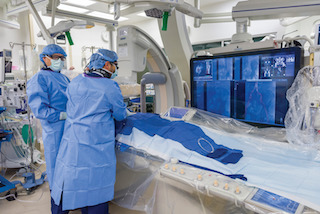
Fighting Cancer with Interventional Radiology
Innovative treatment kills cancer cells while sparing nearby healthy tissue.
The goal of cancer treatment is to destroy cancerous cells without harming other parts of the body. Interventional radiology uses imaging techniques – real-time X-rays, ultrasound, CT, or MRI – to guide treatments right to the cancer site, focusing directly on tumors or their blood supplies.
Often, interventional radiology is an alternative to surgery, providing minimal recovery times and a low risk of complications.
“These are same-day procedures. People come in, get treatment, and go home. They maintain their quality of life with few complications, and they are back with their loved ones almost immediately,” says Anil Pillai, M.D., Chief of the Vascular and Interventional Radiology Division at UT Southwestern.
Doctors use interventional radiology to help diagnose and treat a range of cancers. Here, Dr. Pillai explains how it works in treating three challenging types of cancer.
“These are same-day procedures. People come in, get treatment, and go home. They maintain their quality of life with few complications, and they are back with their loved ones almost immediately.”
Battling Primary and Secondary Liver Cancers
People with primary liver cancer (cancer originating in the liver) often also have liver damage from cirrhosis, hepatitis, or other causes. “This type of cancer has the second-highest rate of cancer-related death, and that rate is growing. It’s a significant problem,” Dr. Pillai says.
Treatment options for primary liver cancer need to be carefully considered. Because their livers are damaged, patients often are not good candidates for surgery. The chemotherapy options available to them are not very effective, and the immunotherapy and biological agent options are still investigational or reserved for very advanced cancer.
External beam radiation – where radiation beams are directed from outside the body to the liver – is an option. But many tumors are not easily accessible. “You can cause collateral damage to the liver or bowel in getting to these lesions,” Dr. Pillai explains.
Interventional radiology gives patients two additional treatment options. With one, doctors use angiographic techniques to access the tumor blood supply to deliver radiation or chemotherapy directly to the artery supplying the tumor. By thus targeting only the tumor, the damage to surrounding liver or bowel tissue is avoided. In addition, the tumor is also deprived of blood supply, which enhances the eradication of tumor cells.
With the second option, doctors can use imaging to guide a needle into the center of the tumor, where they can then kill the tumor cells by inducing thermal injury. Heating by radiofrequency (microwave energy) or cooling by creating an ice ball over the tumor (cryoablation) are mechanisms of destroying tumors using thermal injury.
Some people have secondary liver cancer – cancer that started somewhere else in the body and spread to the liver. “In those cases, patients have more choices because they usually have normal liver function,” Dr. Pillai says. If surgery and chemotherapy aren’t effective, they can try interventional radiology treatments.
Treating Cancer that Strikes the Kidney
People with kidney cancer can also benefit from interventional radiology treatments. “If kidney cancer is very small – less than 3 centimeters – patients do not need to undergo extensive surgery,” Dr. Pillai says. Instead, using imaging guidance (CT or ultrasound), doctors can insert a needle into the tumor and use heat or cold to destroy the cancerous cells, the same way they do for the liver.
For larger kidney tumors, doctors can use interventional radiology to block off the blood flow to part of the kidney, a technique that can allow patients to undergo surgery with less blood loss.
Easing the Pain of Bone Cancer
Bone cancer often is very painful, and these tumors can’t be surgically removed without destroying the bone. With interventional radiology, doctors can destroy the tumor with heat and then put bone cement in its place to reinforce the bone and make it easier for patients to bear weight.
“After this treatment, patients are often relieved of pain, and they can walk around. The need for narcotic medication is reduced, and the patients have a better quality of life,” Dr. Pillai says. This procedure can be done in the spine and in the longer bones of the body.
Learn more about radiology services at UT Southwestern.

The Vanguard
Learn about the latest advances in cancer care, research, and technology inside this publication from UT Southwestern's Simmons Cancer Center.










